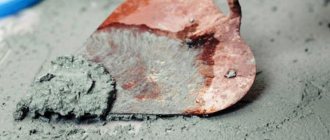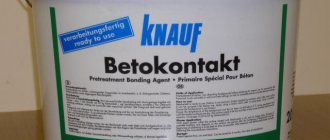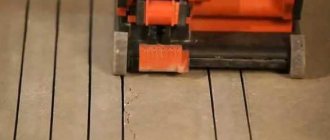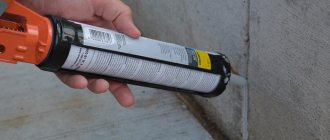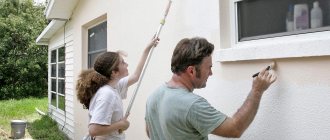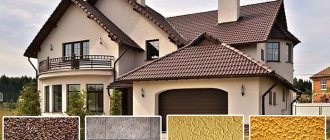Concrete structures are distinguished by their special strength, but any materials can collapse under the influence of external factors. This also applies to concrete; time and various influences lead to the spalling of part of the material, which ultimately leads to cracking of larger zones. To prolong protection and create a more attractive appearance, concrete varnish is often chosen. But you need to know which option is best. This will be discussed in the article.
Varnish for stone and concrete - composition and properties
Varnish products for concrete, stone and other similar materials can be produced using different components. Incoming elements affect the technical characteristics of the varnish. Additional products can also be used to give a certain effect to the coating: matte, glossy, semi-gloss.
The matte type helps to obtain a coating that can hide minor defects, so it is often chosen as a varnish for concrete floors when the room is heavily trafficked. The glossy layer looks more attractive.
There are also special products that have additional endurance. For example, varnishes that can withstand high temperatures are used to treat stoves, fireplaces, etc. Also frost-resistant for outdoor use. Or with increased wear-resistant properties when the coating is subjected to strong mechanical loads.
The glossy layer looks more attractive.
Benefits of use
The use of varnishes to coat concrete is popular due to the many positive effects it has on the material. The waterproof property is increased, protection against rust is created, and the strength of the structure is also improved. The following advantages of using base varnish can be highlighted:
- Increases surface durability;
- Improves the durability of the material;
- Provides abrasion resistance;
- Frost resistance;
- The appearance of the surface changes for the better.
The waterproof property is increased, protection against rust is created, and the strength of the structure is also improved.
Anhydrous products
Waterless or polyurethane floor varnish can withstand high loads and has high adhesive properties. Therefore, it is recommended even in industrial premises where floors may experience heavy loads.
Polyurethane varnish is suitable for concrete, polymer and self-leveling floors. It can be used as a reliable protective coating for valuable wood and natural stone.
In terms of its composition, polyurethane coating can be one-component or two-component, containing acrylic, urethane or solvent.
Today, this is the most wear-resistant floor varnish. And when buyers are faced with the question of which varnish to cover the OSB board on the floor, the choice is obvious - the most durable and aesthetic of all available - polyurethane.
Types of varnishes for concrete
It is important to choose the varnish correctly; only then will you receive the necessary protection and reliability of the coating. It is necessary to take into account whether the product is used for external or internal work; the requirements for properties in these cases will be different. It’s easier to choose when you know the compositional characteristics of the types, so the existing types of varnishes will be discussed below.
Some craftsmen prepare the varnish themselves using polystyrene foam.
It is important to choose the varnish correctly; only then will you receive the necessary protection and reliability of the coating.
Acrylic and silicone resins as a base for varnish
Acrylic and silicone types are expensive. But the composition is convenient to use; you only need to apply one layer to get the desired decorative and protective effect. A matte coating remains on the surface, which can hide minor flaws in the base.
The composition is convenient to use; you only need to apply one layer to get the desired decorative and protective effect.
Polyurethane varnish
Polyurethane varnish for concrete is especially popular among other types. It is distinguished by its high ability to penetrate into small cracks in the base to ensure complete protection. There is also a special polyurethane-based impregnation, which helps to further enhance the effect.
A reliable barrier is created to prevent moisture from entering the material, and the layer is also wear-resistant, which helps extend the service life of the structure. The cost of the products is low, which further increases the demand for varnish.
It is this type that is usually chosen for treating floors in public institutions, garages and other utility rooms, where operating conditions are characterized by increased loads.
It is distinguished by its high ability to penetrate into small cracks in the base to ensure complete protection.
Polymer varnish for concrete coating
Polymer varnish is also in demand; it helps create a durable coating with protection from various influences, depending on the incoming additives. The compositions typically use styrene. The advantages of such funds are considered to be the following:
- Does not wear out from external influences;
- Improves the strength properties of concrete pavement;
- Water resistance is better than the previous type;
- A barrier is created for various strong influences;
- Drying does not take long, so repair work can be completed faster.
In addition, the cost is low, even taking into account the positive properties described above that are obtained after treating concrete with varnish.
Polymer varnish is also in demand; it helps create a durable coating with protection from various influences, depending on the incoming additives.
Water based varnish
Water bases are rarely used to create varnishes for concrete floors; the stability of such products is low. The layer is not capable of creating reliable protection from various negative effects on concrete, so it is usually chosen only to impart decorative properties. A surface layer is created against moisture penetration, but the coating is not suitable for long-term loads.
There are also epoxy types that create a durable coating and are a two-part type.
A surface layer is created against moisture penetration, but the coating is not suitable for long-term loads.
Scope of application of acrylic protection
Concrete varnish containing acrylic filler is in demand for decorative finishing while simultaneously providing protective properties:
- concrete floors with decorative mosaics;
- natural stone;
- artificial materials;
- brickwork;
- borders;
- decorative paving stones.
As a result of application, the material creates the illusion of wet stone. It is used for treating concrete floors in warehouse complexes, shopping centers, and manufacturing enterprises.
During the processing process, the concrete is deeply impregnated with an acrylic composition, allowing further priming, if necessary. The use allows you to remove dust from the surface of a concrete mass that does not absorb significant forces.
Color and various additives
When choosing when to cover an important area, pay attention to the decorative properties. The color scheme helps to add the necessary addition to the interior; varnishes can give a tint change.
But the coating also differs in the resulting effect: gloss, matte, semi-matte and semi-gloss. Here you should choose based on the design and preferences of the owner of the room.
The color scheme helps to add the necessary addition to the interior; varnishes can give a tint change.
Why do you need floor varnishing?
Varnishing serves to protect and guarantee the safety of the wooden material.
Having decided to opt for wooden material for floor areas, the owner not only ensures an aesthetic component, but also environmental cleanliness. Practical and natural material, with proper care, will last an incredibly long time, which is why varnish is needed.
The tree is subject to the harmful effects of various external and internal factors:
- scratches;
- getting wet;
- abrasion;
- rotting;
- damage by insects;
- drying out;
- delamination.
Varnishing serves to protect and guarantees that the wooden material is not susceptible to almost all of the above factors, and the fact that varnished wood looks much more beautiful should not be ignored.
Attention! With proper preparation, the varnishing process will not cause any difficulties. The choice of varnish does not matter: clear, colored or tinted, it is only important to choose the composition for the floor covering.
Technology of coating internal and external concrete surfaces with varnish
To obtain not only the required level of protection, but also to create a reliable coating, it is necessary to carry out varnishing correctly. Knowing the intricacies of the work, you can carry out the process yourself, without turning to professionals, significantly saving money.
To obtain not only the required level of protection, but also to create a reliable coating, it is necessary to carry out varnishing correctly.
Surface preparation
An important stage is the preparatory stage, so that the layer remains on the surface longer and no flaws are visible. You need to follow the instructions below:
- The base must be thoroughly cleaned of all types of contaminants.
- When white spots are found on the concrete base, they are removed by grinding. These stains form due to salt exposure.
- A primer solution is applied to the concrete, this layer serves to extend the durability of the material and the varnish layer, and increases the degree of adhesion.
A primer solution is applied to the concrete.
Applying varnish
The varnish is also applied using a special technology. Beginners should carefully study the intricacies of the work. The specialist is advised to act as follows:
- The tool for distributing varnish over the base can be brushes, rollers or a spray gun;
- First, apply one layer to the base that has dried after priming, it is important that it is completely dry before the second;
- In some cases, the second layer may not be applied, depending on the selected composition and the condition of the surface.
First, apply one layer to the base that has dried after priming; it is important that it is completely dry before the second.
How many layers do you need?
The choice of how many layers will need to be applied is made taking into account the manufacturer’s recommendations. But most often, at least two layers are required for high-quality protection. Increasing the number of layers increases the consumption of varnish, but the durability of the coating justifies the expense.
Most often, at least two layers will be required for high-quality protection.
How long does it take to dry
Drying of each layer must be done completely, usually it takes 2-4 hours. You can walk on the flooring after varnishing after 5 hours; the exact data is indicated on the packaging of the product. And it will be possible to put full loads on the floors only after 24 hours.
Drying of each layer must be done completely, usually it takes 2-4 hours.
What to choose for your dacha
Thanks to the fact that manufacturers have developed varnishes for exterior and interior use, consumers have the opportunity to create a unique and practical interior not only at home, but also in a country house.
Varnish for a wooden floor in a country house must be chosen with special care. The fact is that not every coating may be suitable. Experts recommend paying special attention to the type of wood from which the floor in the country house is made. Many summer residents prefer to make their country house floors from pine boards in order to save money.
The features of this type of wood include its softness and ability to bend under pressure. That is, the floor can easily become deformed.
Therefore, the varnish for the floor in the country should be chosen taking into account the type of wood, humidity in the room and temperature conditions.
Attention! The most common parquet varnish cannot be used for softwood: when applied to the wood, a hard film is formed, which will destroy the structure of the wood during use of the pine floor.
Soft wood will sag, but its hard, treated surface will remain in place. A void is formed between the wood and the coating. After some time, this void increases and a crack may appear on the tree.
When choosing a varnish for a pine floor, you should pay attention to the corresponding mark on the can. It is preferable to choose a product that says on the packaging: for soft wood and floorboards.
Another feature of softwood coating is the method of its application. The parquet floor is first primed, and pine wood floor varnish is applied directly to the boards. Pine boards should not be primed; in this case, the basis for applying the coating will be the first layer of varnish.
Attention! Varnishes for pine floors must be elastic.
The product for outdoor use should protect the wood from moisture, wind, sunlight and sudden temperature changes.
Finnish floor varnish Tikkurila is a reliable and wear-resistant coating for any type of wood that can withstand high humidity and temperature changes. It can be used both for interior decoration and for exterior decoration, for example, to cover the floor on a veranda, since this varnish for dacha floors is frost-resistant.
Products used for external work can be used for:
- Terrace
- External railings and stairs
- Balconies
- Gazebos
- Wooden garden furniture
Features of selection, by what criteria
Knowing the types of products and features, it is still difficult to decide on the choice of the best varnish, because there are a large number of compositions on the construction market. The following selection criteria should be taken into account:
- You shouldn’t try to save a lot; reliable protection can only be created by high-quality products, usually this applies to well-known brands;
- You can focus on brands that are especially popular. Now these are Texol, Tistrom;
- Look at the varnish consumption indicator to calculate the required volume of varnish;
- They think in advance what protective properties will be needed: the level of moisture resistance, wear resistance, resistance to low and high temperature influences, etc. When choosing, study the label, which states the technical characteristics of the varnish product;
- Decorative features described above are the effect of matte and gloss. Usually, matte types are chosen for interior work, glossy ones for exterior work, or neutral options are used - semi-matte varnishes.
You shouldn’t try to save a lot; only high-quality products can create reliable protection.
Varnishes for concrete bases can give a beautiful external effect and will also serve to extend the service life of the material. An additional layer is created that does not allow water to pass through and withstands other negative impacts during operation. If varnishing is carried out according to the rules, the coating will please the eye for a long time.
Famous manufacturers
Modern industry offers the buyer a wide range of paints and varnishes. Examples are presented in the table:
| Brand and type | Properties | Application |
| "Texol" - polymer varnish for concrete | Versatility and ease of use at work | Concrete, brick, stone |
| Moisture and wear resistance | ||
| "Tistrom" is a one-component polyurethane product | Chemical resistance, hydraulicity | Brick, metal stone |
| Resistance to mechanical stress | ||
| Strong - silicone | Hardening, waterproof effect | For interior work with stone |
| "Dali" - acrylic-silicone varnish | Shockproof properties, moisture resistance | For stone and brick surfaces |



